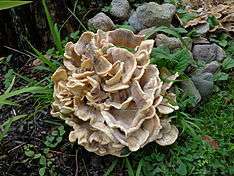Meripilus sumstinei
| Meripilus sumstinei | |
|---|---|
 | |
| Scientific classification | |
| Kingdom: | Fungi |
| Division: | Basidiomycota |
| Class: | Agaricomycetes |
| Order: | Polyporales |
| Family: | Meripilaceae |
| Genus: | Meripilus |
| Species: | M. sumstinei |
| Binomial name | |
| Meripilus sumstinei (Murrill) M.J.Larsen & Lombard (1988) | |
| Synonyms[1] | |
Meripilus sumstinei, commonly known as the giant polypore or the black-staining polypore, is a species of fungus in the family Meripilaceae. Originally described in 1905 by William Alphonso Murrill as Grifola sumstinei, it was transferred to Meripilus in 1988.[1] It is found in North America, where it grows in large clumps on the ground around the base of oak trees and tree stumps. The mushroom is edible.[2]
References
- 1 2 "GSD Species Synonymy: Meripilus sumstinei (Murrill) M.J. Larsen & Lombard, Mycologia 80(5): 615 (1988)". Species Fungorum. CAB International. Retrieved 2014-07-23.
- ↑ Russell B. (2010). Field Guide to Wild Mushrooms of Pennsylvania and the Mid-Atlantic. Penn State Press. p. 128. ISBN 978-0-271-04526-9.
External links
This article is issued from
Wikipedia.
The text is licensed under Creative Commons - Attribution - Sharealike.
Additional terms may apply for the media files.